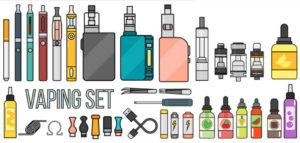Quick Facts:
The use of vaping devices by teens is a trend alarming parents, teachers and administrators.
- Electronic cigarettes are battery-operated devices that people use to inhale an aerosol, which typically contains nicotine (though not always), flavorings, and other chemicals. In many e-cigarettes, puffing activates the battery-powered heating device, which vaporizes the liquid in the cartridge or reservoir. The person then inhales the resulting aerosol or vapor (called vaping).
- E-cigarettes are popular among teens and their use is growing exponentially. According to the CDC, vaping by high schoolers jumped from just 1.5% in 2011 to 20.8% in 2018. Even more concerning is the fact that e-cigarette use by high schoolers increased by 78% from 2017-2018 (from 11.7% to 20.8%).
- Under U.S. Food and Drug Administration (FDA) regulations designed to protect the health of young Americans, minors can no longer buy e-cigarettes in stores or online and new FDA action will limit the sale of flavored “juices” to teens.
- Research so far suggests that e-cigarettes are less harmful than cigarettes when people who regularly smoke switch to them as a complete replacement. But e-cigarettes can still damage a person’s health.

- E-cigarettes can lead to nicotine addiction and increased risk for addiction to other drugs.
- Nicotine stimulates the adrenal glands to release the hormone epinephrine (adrenaline) and increases the levels of a chemical messenger in the brain called dopamine. The activity of dopamine in the brain’s reward system motivates some people to use nicotine again and again, despite possible risks to their health and well-being.
- E-cigarette use also exposes the lungs to a variety of chemicals, including those added to e-liquids, and other chemicals produced during the heating/vaporizing process.
Talking to your teens about vaping is the best way to protect their health.
But before you begin, it is important to have credible information about vaping, vaping products and their health impacts. There are many resources available to help you have a productive conversation.
For starters, here is a tip sheet on talking to your children about e-cigarettes from the CDC: SGR_ECig_ParentTipSheet_508.
In January, 2018, NCUFY cosponsored a presentation about vaping featuring Dr. Richard Stumacher of Northern Westchester Hospital, and others including Student Assistance Counselor Carolyn D’Agostino. Dr. Stumacher’s power point contained a wealth of information about vaping, youth and health hazards and can be viewed here. You can also watch the video of the full evening presentation using this link
Many vaping “juices” contain large quantities of nicotine, which can quickly become addicting and difficult to quit. Share this New York Times article with your kids of one teen’s quick path to Juul addiction and difficult withdrawal.
Some additional articles to help you prepare for your conversation:
U.S. News and World Report, How to Talk to Your Teens About Vaping
Science News for Students, Vaping Articles Collection
Vaping devices have come a long way since first generation e-cigarettes.
Do you know the difference between an e-cigarette and a hookah? Have you heard teens talking about “juuls” or “juuling”? Did you know that “vape mod” devices using “e-juice” (which comes in varying concentrations of nicotine) are also popular? And that these devices allow for other types of material, such as marijuana or THC oil or wax, to be vaped?
Reading this vaping primer prepared by Vaping Daily will arm you with this information and help you understand how vaping businesses are marketing their products. You can learn more about why the Juul has become so popular with teens and why this trend is so alarming by watching this video.
As vaping technology continues to evolve, science is struggling to keep up with current information about the health impacts of vaping. Recent news reports about serious lung disease linked to vaping makes it clear that vaping is not without health risks. It’s also well known that nicotine is highly addictive (and can even be toxic if taken in large amounts) which makes it hard for teens to stop vaping once they have started.
https://www.scientificamerican.com/article/e-cigs-and-second-hand-vaping/
https://www.thetruth.com/articles/hot-topic/e-cigs-and-vaping
http://newcastleunitedforyouth.org/new-vaping-health-concerns/
How to Help Your Teen Stop Vaping
Anyone who has ever experienced nicotine addiction knows that a cold turkey approach is difficult, if not impossible. That’s why it’s important for parents who discover their teen is vaping to take the time to think about how to help them to stop rather than simply confiscate the device(s) and forbid the behavior. Even a teen who decides they are ready to stop may not be successful unless they understand the nature of nicotine withdrawal and what motivated them to start vaping in the first place.
By helping your child to create a vaping cessation plan you can be helping them kick the habit for good. For some pointers and things to consider with your child, review the Had enough? -_Quitting Vaping guide put together by Greeley Student Assistance Counselor Carolyn D’Agostino using resources from smokefree.gov. It contains lots of helpful suggestions and resources for topics like dealing with cravings and nicotine withdrawal, understanding your vaping triggers and how to stay committed to quitting.
Also consider suggesting teen-friendly resources to help stop vaping. Two good options are the quitSTART app which teens can download on their cellphones and the daily text support provided by SmokefreeTXT which teens can sign up for online or by texting QUIT to 47848.
